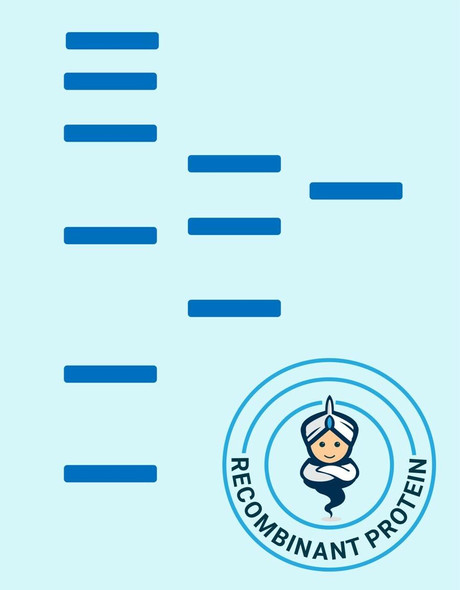Description
| Product Name: | Mouse FGF 2 Recombinant Protein |
| Product Code: | RPPB0212 |
| Size: | 50µg |
| Species: | Mouse |
| Target: | FGF 2 |
| Synonyms: | HBGF-2, Prostatropin, FGF-2, FGB-b. |
| Source: | Escherichia Coli |
| Physical Appearance: | Sterile Filtered White lyophilized (freeze-dried) powder. |
| Formulation: | FGF-b was lyophilized from 5mM Na2PO4, pH7.5 and 50mM NaCl. |
| Solubility: | It is recommended to reconstitute the lyophilized Fibroblast Growth Factor�b in sterile 18M-cm H2O not less than 100�g/ml, which can then be further diluted to other aqueous solutions. |
| Stability: | Lyophilized Fibroblast Growth Factor-2 although stable at room temperature for 3 weeks, should be stored desiccated below -18°C. Upon reconstitution FGF-basic should be stored at 4°C between 2-7 days and for future use below -18°C.For long term storage it is recommended to add a carrier protein (0.1% HSA or BSA).Please prevent freeze-thaw cycles. |
| Purity: | Greater than 95.0% as determined by SDS-PAGE. |
| Amino Acid Sequence: | MPALPEDGGA AFPPGHFKDP KRLYCKNGGF FLRIHPDGRV DGVREKSDPH VKLQLQAEER GVVSIKGVCA NRYLAMKEDG RLLASKCVTE ECFFFERLES NNYNTYRSRK YSSWYVALKR TGQYKLGSKT GPGQKAILFL PMSAKS |
| Biological Activity: | The activity as calculated by the dose-dependant proliferation of BALB/3T3 cells was found to be less than 1ng/ml corresponding to a specific activity of 1,000,000 units/mg. |
FGF-basic is a member of the fibroblast growth factor (FGF) family. FGF family members bind and possess broad mitogenic and angiogenic activities. This protein has been implicated in diverse biological processes, such as limb and nervous system development, wound healing, and tumor growth. The mRNA for this gene contains multiple polyadenylation sites, and is alternatively translated from AUG and non-AUG (CUG) initiation codons resulting in five different isoforms with distinct properties. The CUG-initiated isoforms are localized in the nucleus and are responsible for the intracrine effect, whereas, the AUG-initiated form is mostly cytosolic and is responsible for the paracrine and autocrine effects of this FGF.The binding growth factors are angiogenic agents in vivo and are potent mitogens for a variety of cell types in vitro. there are differences in the tissue distribution and concentration of these 2 growth factors.
Fibroblast Growth Factor-basic Mouse Recombinant (FGF-2) produced in E.Coli is a single, non-glycosylated, polypeptide chain containing 146 amino acids and having a molecular mass of 16.3kDa. The FGF-2 is purified by proprietary chromatographic techniques.
| UniProt Protein Function: | FGF2: Plays an important role in the regulation of cell survival, cell division, angiogenesis, cell differentiation and cell migration. Functions as potent mitogen in vitro. Monomer. Homodimer. Interacts with FGFR1, FGFR2, FGFR3 and FGFR4. Affinity between fibroblast growth factors (FGFs) and their receptors is increased by heparan sulfate glycosaminoglycans that function as coreceptors. Interacts with CSPG4, FGFBP1 and TEC. Found in a complex with FGFBP1, FGF1 and FGF2. Expressed in granulosa and cumulus cells. Expressed in hepatocellular carcinoma cells, but not in non- cancerous liver tissue. Belongs to the heparin-binding growth factors family. 4 isoforms of the human protein are produced by alternative initiation. |
| UniProt Protein Details: | Protein type:Activator; Motility/polarity/chemotaxis Cellular Component: extracellular space; cytoplasm; extracellular region; nucleus; cytosol Molecular Function:heparin binding; protein binding; ligand-dependent nuclear receptor transcription coactivator activity; growth factor activity; cytokine activity; chemoattractant activity; receptor binding; fibroblast growth factor receptor binding Biological Process: wound healing; activation of MAPKK activity; regulation of cell cycle; multicellular organismal development; positive regulation of transcription, DNA-dependent; positive regulation of smooth muscle cell proliferation; adrenocorticotropin hormone secreting cell differentiation; cardiac muscle cell proliferation; thyroid stimulating hormone secreting cell differentiation; hyaluronan catabolic process; growth factor dependent regulation of satellite cell proliferation; embryonic development ending in birth or egg hatching; positive regulation of MAP kinase activity; negative regulation of cell proliferation; substantia nigra development; glial cell differentiation; positive chemotaxis; induction of an organ; positive regulation of cell proliferation; regulation of retinal cell programmed cell death; response to axon injury; angiogenesis; cell differentiation; positive regulation of granule cell precursor proliferation; positive regulation of cardiac muscle cell proliferation; fibroblast growth factor receptor signaling pathway; positive regulation of cell fate specification; positive regulation of blood vessel endothelial cell migration; positive regulation of phosphoinositide 3-kinase activity; negative regulation of blood vessel endothelial cell migration; positive regulation of protein kinase B signaling cascade; positive regulation of osteoblast differentiation; positive regulation of angiogenesis; stem cell development; cell migration during sprouting angiogenesis; ureteric bud branching; positive regulation of cell division; release of sequestered calcium ion into cytosol; phosphatidylinositol biosynthetic process; positive regulation of endothelial cell proliferation; positive regulation of transcription from RNA polymerase II promoter; positive regulation of protein amino acid phosphorylation; positive regulation of cell differentiation; inositol phosphate biosynthetic process; positive regulation of epithelial cell proliferation; lung development |
| UniProt Code: | P15655 |
| NCBI GenInfo Identifier: | 122743 |
| NCBI Gene ID: | 14173 |
| NCBI Accession: | P15655.1 |
| UniProt Related Accession: | P15655 |
| Molecular Weight: | 17,153 Da |
| NCBI Full Name: | Fibroblast growth factor 2 |
| NCBI Synonym Full Names: | fibroblast growth factor 2 |
| NCBI Official Symbol: | Fgf2�� |
| NCBI Official Synonym Symbols: | Fgfb; bFGF; Fgf-2�� |
| NCBI Protein Information: | fibroblast growth factor 2; HBGF-2; basic fibroblast growth factor; heparin-binding growth factor 2 |
| UniProt Protein Name: | Fibroblast growth factor 2 |
| UniProt Synonym Protein Names: | Basic fibroblast growth factor; bFGF; Heparin-binding growth factor 2; HBGF-2 |
| Protein Family: | Fibroblast growth factor |
| UniProt Gene Name: | Fgf2�� |
| UniProt Entry Name: | FGF2_MOUSE |









